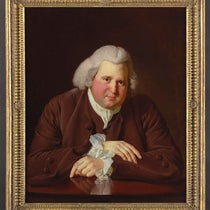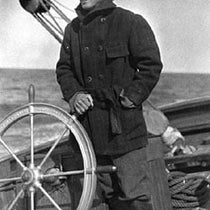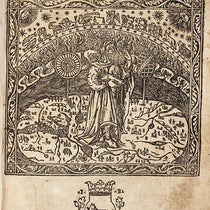Scientist of the Day - Albert Einstein
Albert Einstein, a German/American physicist, died in Princeton, New Jersey, on Apr. 18, 1955, age 76. We have published two posts on Einstein, the first, 9 years ago, on portraits and a bust of Einstein that can be seen in our library, the second, two years ago, on Einstein as a human being. We have yet to write a post on his annual mirabilis of 1905, when he published 4 epochal papers, including the one on special relativity; or on his general theory of relativity that came 10 years later, with its radical new explanation of gravity as a curvature of space-time. But both of those posts will have to wait, as today we discuss the context of Einstein's most famous quotation: "God does not play dice with the world.”
In his later years, from about 1925 on, Einstein was uneasy about the implications of the quantum revolution then taking place. Einstein himself had played a major role in launching that revolution, when he showed (in one of his 1905 papers) that light consists of quanta, tiny bundles of energy, which have both particle and wave properties. But when Werner Heisenberg and Max Born began interpreting the wave equations of quantum mechanics as indicating the probabilities that an electron might be found at this place, or that place, as if the electron had no reason to be in one particular location, Einstein was unhappy. And when Heisenberg unveiled his uncertainty principle, asserting we can never know the precise position and momentum of a particle at the same time – we will always be uncertain of one or the other – Einstein had had enough. He spent considerable time for much of the rest of his life (spent after 1933 at the Institute for Advanced Study in Princeton) trying to find hypothetical situations – paradoxes – in which the uncertainty principle could not be true. His foil for most of these mind-games was Niels Bohr, the Danish physicist who had no problems accepting the implications of quantum theory for our picture of reality. Every time Einstein came up with an example that seemed to refute Heisenberg's uncertainty principle, Bohr would retreat, mull the matter over, and point out to Einstein, the next time they met, how the problem could be resolved without violating uncertainty. Apparently, this happened frequently at the Solvay Conferences in Brussels in 1927 and 1930, and at Paul Ehenfest’s house in Leyden on other occasions (see all four images).
The concept of quantum superposition was bothersome to Einstein as well. First advanced in 1935 in the form of Schrödinger's cat, quantum superposition maintains that an object or particle can be in two contradictory states at once, and a resolution only occurs when an observer intervenes. The cat is both alive and dead until someone opens the box. That just seemed wrong to Einstein.
With his qualms about quantum mechanics, coupled with the fact that general relativity was almost totally ignored in the 1940s and 50s, Einstein grew increasingly estranged from mainstream physics, which was a sad thing. It is too bad he couldn't have lived another 15 years, to see general relativity come back strong, with the discovery of black holes, gravitational waves, and gravitational lensing. No one has yet managed to combine quantum mechanics with general relativity, but they are working on it. And who knows, perhaps Einstein may turn out to be right – quantum physics may be incomplete, as he always maintained – and when they finish it, God may be able to put those dice away.
William B. Ashworth, Jr., Consultant for the History of Science, Linda Hall Library and Associate Professor emeritus, Department of History, University of Missouri-Kansas City. Comments or corrections are welcome; please direct to ashworthw@umkc.edu.








![Using an astrolabe to measure the depth of a well, woodcut in Elucidatio fabricae vsusq[ue] astrolabii, by Johannes Stöffler, 1513 (Linda Hall Library)](https://assets-us-01.kc-usercontent.com:443/9dd25524-761a-000d-d79f-86a5086d4774/a998eb50-55d2-4a88-ace2-a50aa5fa86e7/Stoffler%201.jpg?w=210&h=210&auto=format&fit=crop)

